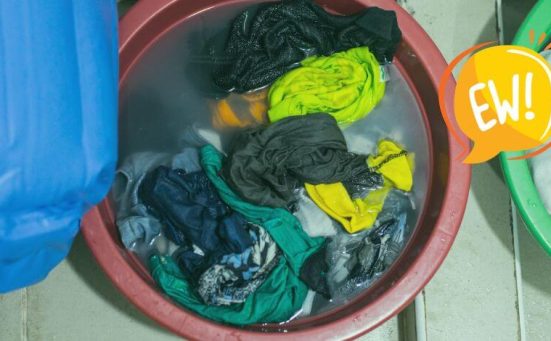
Do This If Your Duvet Doesn’t Fit In Your Washing Machine
Most people use duvets on their beds nowadays because they are warm and lightweight. Plus, as many duvets use a cover, it makes changing the bedding style a relatively simple way to update your bedding.
This means you won’t need to wash the actual duvet so often as you can just wash and replace the cover. However, the duvet will need to be washed at some point. In fact it is recommended that you should wash your duvet every few months or at least twice per year.
If you own a king size bed, and the actual duvet won’t fit in your washing machine, keep reading. Because in this article we’ll show you the best alternative ways to wash your duvet.
Never Force A King Size Duvet Into A Small Washing Machine
With people leading such busy lives nowadays, you might be tempted to force your king size duvet into a small washing machine. Our advice to you is don’t do it. You should never wash a duvet in a home washing machine unless it meets the following criteria;
| Washing Machine Capacity | Duvet Size |
|---|---|
| 6 kg | Single Duvet |
| 7 kg | Double Duvet |
| 8 kg | Queen Size Duvet |
| 9 kg + | King Size Duvet |
As you can see your washing machine needs to have a capacity of at least 9 kg before you should attempt to fit a king size duvet into the drum.
Even if you have a 9 kg capacity washing machine, you must ensure that the duvet fits in loosely and has enough space to let water and detergent flow through the duvet and the drum freely.
Before Washing A Duvet
Before you wash any duvet there are a few things you need to do. These include;
- Check the care label
Care labels are there to ensure that you care for your duvet correctly. It will likely tell you whether the duvet can be washed (or dry cleaned), the maximum temperature to wash it at, as well as drying instructions etc. - Use the correct detergent
If your duvet is filled with down or feathers, you can only use non-biological detergent to wash it. Whereas a synthetic filled duvet can be washed using any detergent. - Allow sufficient drying time
Duvets will absorb lots of water during the washing process. This means they’ll take a long time to dry unless you use a large enough tumble dryer (it’s unlikely that your home tumble dryer will be able to cope with a king size duvet). Feather and down duvets will need extra drying time as the filling could rot if not fully dry.
Alternative Ways To Wash Duvets Too Large For Your Washing Machine
If your washing machine’s capacity is too low to successfully wash your duvet, you’ll need to find an alternative way to wash it.
We have found a few alternative ways of washing duvets without using your home washing machine. Which include;
Using A Laundrette To Wash A King Size Duvet
This is the easiest way to wash and dry your oversized duvet as long as there is a laundrette in your local area. Laundrettes use industrial sized washing machines and tumble dryers which will have the capacity to accommodate your king size duvet.
Remember that many laundrettes have washers and dryers that are coin operated. So be sure to take enough change with you.
We have found that packing your king size duvet into a suitcase on wheels is the most convenient way of transporting it to and from the laundrette.
Using A Bath To Wash Your Oversized Duvet
If you have a bath you can wash your large duvet by hand without leaving home. All you need to do is;
- Clean the bath to ensure there are no harmful chemical residues.
- Fill the bath ⅔ full with warm water and add detergent at the recommended amount (check the container for more details) and agitate to mix the detergent in.
- Remove the duvet cover and wash separately.
- Place the duvet into the water and completely submerge.
- Allow the duvet to soak for 5 to 10 minutes.
- Remove the plug to allow some of the water to drain. Put the plug back in when it is around half the level it was at before removing the plug.
- Now move the duvet around to ensure that all areas have been exposed to the detergent.
- Knead the duvet to force water and detergent all through the duvet.
- Rinse the duvet using an over bath shower if available or just use the cold tap.
- Keep rinsing until the water runs clear (with no dirt or soap suds).
- Squeeze as much water from the duvet as you possibly can.
- Wring the remaining water from the duvet.
- Shake the duvet to fluff it up.
- Hang the duvet on the washing line and allow it to dry naturally (this could take all day and is best done during the Summertime on long, hot days).
Why Do You Need To Wash A Duvet?
As we sleep we lose dead skin, cells and sweat many of which are absorbed into the duvet. Over time this build up of skin is the perfect breeding ground for bed bugs.
Bed bugs feed on blood and bite you while you are sleeping. These bites can be no more than simple irritations or they could turn into something more serious.
Bed bugs can cause anaphylaxis shock, ecthyma, impetigo and lymphangitis.
Even without the threat of bed bugs and the infections they can cause, you’ll find you sleep better in a bed with a freshly washed and dried duvet.
When Should You Replace Your Duvet?
Your duvet should be replaced every 5 years, but you’ll know if it needs to be replace sooner because it will display one of the following;
- Starts To Rip
If your duvet has started to rip and has slight tears in the fabric, it will allow the filling to fall out. This will make your duvet allow cold air in and you will no longer feel warm at night. - Becomes Thinner
If your duvet is a few years old and has been used regularly, it can become thinner in places. This will mean it no longer traps air and will therefore no longer keep the cold out. - Develops Lumps
Duvets usually develop lumps if they have been washed too often. If the lumps cannot be shaken out and the duvet won’t fluff up, you’ll need to replace it.
When the time comes to replace your duvet, you should always buy the best quality duvet you can afford. That old saying “buy cheap, buy twice” is especially true of duvets.
Top quality duvets will last longer and also keep their structure far better than cheaper made and sold duvets.
Frequently Asked Questions
It is recommended that a duvet should ideally be washed 3 to 4 times per year or at least twice a year.
Whether a king size duvet is too big for a washing machine depends on the washing machine’s capacity. You will need a 9 kg washing machine to successfully wash a king size duvet.
A double duvet will usually fit in a 7 kg washing machine. You will need an 8 kg washing machine for queen duvet and a 9 kg washing machine for a king size duvet.
To wash a king size down duvet you will need a washing machine with a minimum capacity of 9 kg. You should then select the delicate or gentle cycle and use a non-biological detergent or a detergent designed for feather or down filled duvets. Select a cool wash, not a cold wash or a hot wash, but a lukewarm wash. An extra rinse should also be added at the end of the wash cycle.
You can wash your duvet in the bath but you should always ensure the bath is clean and free from any chemicals before starting. Then ¾ fill the bath with warm water and add detergent at the recommended amount (check the container for more details) and agitate to mix the detergent in. Then fully submerge the duvet and let it soak for around 10 minutes. It is then time to gently knead the duvet to ensure the water and detergent get into all of the duvet. Rinse thoroughly before drying on the washing line.
Also, follow us on Pinterest ...



